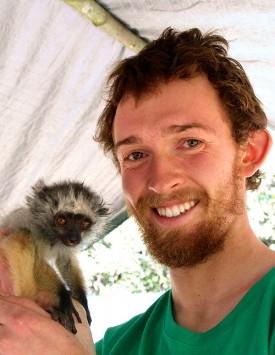Dr. Brandon Semel
PHD FELLOW GRADUATE | Global Change Center
VT Graduate February 2021, Fish and Wildlife Conservation
Advisor: Dr. Sarah Karpanty
Website • bsemel@vt.edu

Dr. Brandon Semel successfully defended his dissertation in February 2021, titled “Factors affecting golden-crowned sifaka (Propithecus tattersalli) densities and strategies for their conservation”. Brandon graduated from Virginia Tech with a Ph.D. from the department of Fish and Wildlife Conservation in May of 2021. He currently works as a Biologist for the US Fish & Wildlife Service at Big Stone National Wildlife Refuge in Minnesota.
While primatologists are typically found in anthropology departments, Brandon seeks to break that mold. After receiving a B.S. in Evolutionary Anthropology and Environmental Science from Duke University and an M.A. in Anthropology from Northern Illinois University (NIU), he is currently pursuing my PhD in Dr. Sarah Karpanty’s lab in Virginia Tech’s Fish and Wildlife Conservation Department.
In the Midwest, he grew up in the world of wildlife management. Brandon began banding wood ducks (Aix sponsa) at an early age and often volunteered with the Illinois Department of Natural Resources where he engaged in wetland bird surveys, habitat restoration, and prescribed burns to maintain native prairies. He was also hired to maintain, restore, and survey threatened prairie systems as part of the Illinois Natural History Survey’s Natural Areas Inventory (INAI) and on behalf of privately owned Illinois Nature Preserves.
While studying at Duke University, Brandon promoted ex situ lemur conservation efforts at the Duke Lemur Center, home to the world’s largest collection of lemurs outside of Madagascar. Eager to apply what he learned about conservation to Madagascar, Brandon completed his first fieldwork in Madagascar as a research assistant under Dr. Luke Dollar. He engaged in extensive vertebrate surveys and trapping efforts to establish the effects of human encroachment on the main predator of large-bodied lemurs, the fossa (Cryptoprocta ferox).
Several subsequent research and educational expeditions to Madagascar (as a leader with Operation Wallacea and a student through SIT Study Abroad) provided Brandon with a better understanding of Madagascar’s natural treasures and its beautiful cultural heritage. His projects investigated the effects of habitat disturbance on critically endangered silky sifakas (Propithecus candidus) in the northeastern rainforests and on endangered Verreaux’s sifakas (Propithecus verreauxi) in the southern spiny forests. He also investigated the use of different sampling techniques for estimating population densities in extreme environments.
As a masters student, Brandon worked with the foremost expert on diademed sifakas (Propithecus diadema), Dr. Mitchell Irwin. Brandon investigated the ecological function of soil consumption, or geophagy, for this critically endangered sifaka and common brown lemurs (Eulemur fulvus) in eastern rainforests. The latter has been completely extirpated from forest fragments due to hunting and the removal of large fruit trees by local people. Continued cultural immersion provided Brandon with firsthand accounts of the challenges faced by the Malagasy people to provide food and finances for their families in one of the world’s most malnourished and impoverished nations, often at the cost of incredibly diverse and fragile ecosystems.
Lemurs are now considered earth’s most threatened mammals: 24 of 103 species are critically endangered. Habitat destruction for agricultural and grazing expansion, hunting, and now climate change all threaten their persistence in Madagascar. Brandon is particularly interested in species’ responses to these anthropogenic pressures. His current work looks at understanding how species responded to past climate-driven environmental change, which is critical to informing species management decisions in relation to present and future changes. To that end, he is studying golden-crowned sifakas (Propithecus tattersalli) in northern Madagascar. Understanding the behavioral adaptations, historical distribution, and genetic diversity that enabled this species to successfully overcome severe population declines driven by historic climate fluctuations will ensure the survival of this and many other species for years to come.
Novel technologies, such as advanced telemetry and geospatial techniques, population genetics, aerial drone surveys, and historical climate and species distribution reconstructions will enable us to meet conservation challenges of the future. Brandon is excited by the interdisciplinary community fostered by the IGC Program, and feels it will be invaluable as he creates the network of experts needed to help him master new technologies, re-evaluate historical conservation approaches in Madagascar, and face these global social and environmental challenges head on.
Last updated June 2025.




